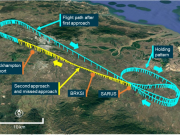Prescriptive limits alone are not enough to prevent extreme fatigue during night flights, according to a new study by the European Union Aviation Safety Agency (EASA).1
A report on the study, published in late February, recommended the implementation of several enhanced fatigue mitigation measures to combat fatigue, including development of a strategy to “promote more decisively the use of resting opportunities in the context of night duties.” Other recommendations included a call for EASA to conduct new research into the effectiveness of flight time limitations.
The study — described as the largest fatigue study of crews throughout Europe — was part of a review that began in 2017 of the effects on crew alertness of a variety of starting times and lengths of duty times, including duty periods of more than 13 hours beginning at “the most favourable time of the day,” duty periods that include more than six sectors, on-call duty followed by flight duties, and “disruptive” schedules2 — schedules in which a crewmember’s sleep opportunity is interrupted during the optimal time for sleep.
Data were obtained from three sources: an online survey of more than 15,000 crewmembers, rosters covering 260,000 flight duty periods (FDPs) and a field study with 24 participating commercial air transport operators and 381 participating crewmembers.
Results from the online survey and an analysis of a range of possible schedules ranked aircrew duty periods according to the severity of fatigue, concluding that the two most fatiguing schedule types were “night duties longer than 10 hours” and “disruptive schedules.”
Data on fatigue, sleepiness, mental effort and sleep were collected from the 24 operators and 381 crewmembers over 14 consecutive days, and objective sleep measurements validated sleep log data that had been collected online, the report said.
The field study found an increased probability of high fatigue levels3 at top of descent during night flights and duty periods with late finishes, the report said. The document added that there was no significant increase in the probability of high levels of fatigue at top of descent (TOD) — the point during a flight at which the en route phase ends and the planned descent begins — for early flight duty periods (FDPs) and only “a marginal increase … for mixes of disruptive schedule FDPs.”
The field study found an increased probability of fatigue at TOD during night and late-finishing FDPs4 but detected no significant difference in TOD fatigue during night flights of more than 10 hours in comparison with shorter night FDPs.
“Night FDPs, both longer and shorter than 10 hours, were associated with an increased probability of high fatigue at TOD,” the report said. “This is not fully reflected in the current FTL [flight and duty time limitations and rest requirements] regulation and guidance material. The regulation and guidelines explicitly note the need for appropriate fatigue risk management and the importance of obtaining sufficient sleep in relation to night duties longer than 10 hours but not for those shorter than 10 hours.”
The study identified three subgroups of night FDPs, noting that the probability of high fatigue levels at TOD differed among them:
- FDPs beginning between 0200 and 0459;
- FDPs ending between 0200 and 0559 and beginning at 0159 or earlier; and,
- FDPs ending at 0600 or later and starting at 0159 or earlier.
“The existence of these subgroups is not recognised in the current FTL regulation,” the report said. “Distinguishing these subtypes could help operators to design effective fatigue risk management strategies.”
The report said that the research found no significant increase in the probability of high levels of TOD fatigue for disruptive schedules that were classified as “early start” FDPs and a marginal increase for “mixtures” of disruptive FDPs (in schedules with varied start and finish times).
Fatigue mitigation efforts should involve various fatigue management strategies, depending on the FDP type and “operator context,” the report said.
“Since there are multiple other more influential determinants, the increased fatigue at TOD during longer night duties may be difficult to effectively control by merely adjusting the FDP duration,” the report said. “There are other non-schedule–related strategies for reducing fatigue at TOD during (long) night FDPs. The use of rest before or during FDPs is supported by the findings about the frequency of napping on the flight deck. The frequency was higher than expected, as napping on the flight deck is only allowed to manage unexpected fatigue and to reduce the risk of fatigue during higher workload periods later in the flight.”
Recommendations
Because the characteristics of night FDPs vary among different operators, the report did not include one precise set of recommendations on limiting fatigue. Instead, the report suggested that each operator should manage fatigue risks according to basic principles of fatigue risk management.
Six recommendations contained in the report called for adjusting the definition of a night FDP to reflect understanding of the night FDP subgroups and for requiring operators to apply fatigue risk management to late-finish FDPs — action not required under the current regulation — and to all night FDPs, regardless of their length.
Because the greatest probability of high fatigue at TOD occurred during duty periods starting at 0159 or earlier and ending at 0600 or later, the report said the regulation should define that type of FDP and require special attention in applying fatigue risk management principles to those duty periods.
Another finding linked shorter periods of sleep before all night FDPs with a high level of fatigue at TOD on those lights. In response, the report recommended that existing guidance material for night duties be amended to stipulate that “it is critical for the crewmember to obtain sufficient sleep before all night duties, regardless of FDP duration.” The current guidance applies only to night duties longer than 10 hours.
The report also recommended that, because the amount of sleep obtained before a night FDP is the main predictor of eventual fatigue, operators “should be required to promote optimum use of sleep opportunities (i.e., before reporting and during the FDP).”
Resting Opportunities
The report said that EASA will evaluate the need for rulemaking to amend the existing regulation “with a view to better reflect the different types of night duties.”
The document stressed the shared responsibility of operators and crewmembers to ensure that the crew obtains sufficient sleep.
“The current regulation already describes the need for operators to provide resting opportunities and for crew to make optimum use of such opportunities,” the report said. “As this is essential for effective fatigue risk management, EASA should engage with national civil aviation authorities and industry stakeholders to actively promote the provision and use of rest facilities at or near airports in order to improve the probability of obtaining sleep as close as possible to the start of the night duty, as well as the use of resting opportunities (controlled rest and in-flight rest) in the context of night duties.”
Future research is planned to examine fatigue among crewmembers with duty times lasting more than 11 hours, those with more than six flight sectors during an FDP, those with duty periods of more than 13 hours during the most favorable times of day and those who have been on standby or reserve before reporting to work.
The report said that EASA also should review the effects on FTL regulation of controlled rest — periods of time on the flight deck that may include rest or actual sleep for one flight crewmember at a time. Other research has shown that a controlled nap on the flight deck may significantly increase alertness during later phases of flight (“Controlled Rest,” ASW, 11/18).
Future research also should be aimed at increasing participation by female crewmembers and cabin crew, the report said. Participants in this study were 75 percent male, and 68 percent were pilots.
Notes
- EASA. “Effectiveness of Flight Time Limitation.” Feb. 28, 2019
- The report defines disruptive schedules as those in which “a crewmember’s roster … disrupts the sleep opportunity during the optimal sleep time window.” Typically, a schedule is disruptive because of early starting times, late finishing times or night duties, EASA says.
- Two sleep scales were used to assess high fatigue levels. One scale, the Karolinska Sleepiness Scale (KSS), asks subjects to describe their level of sleepiness at a particular time of day, on a scale from 1 to 10, with 1 indicating “extremely alert” and 10 indicating “extremely sleepy — can’t keep awake.” (Some version of the KSS rate sleepiness on a scale of 1 to 9.) The other scale, the Samn-Perelli Fatigue Checklist (SP), asks subjects to rate their current fatigue on a seven-point scale, with 1 indicating “fully alert, wide awake, extremely peppy” and 7 indicating “completely exhausted, unable to function effectively, ready to drop.” In this study, a high level of fatigue was indicated by a KSS score of at least 7, “sleepy, but no effort to keep awake,” and an SP score of at least 6, “extremely tired, very difficult to concentrate.”
- A night duty period is defined as one including time between 0200 and 0459 local time.
Featured image: © benzoix | VectorStock
Sleepy man sitting on a bed: Vecteezy
Sleeping man: Vecteezy


